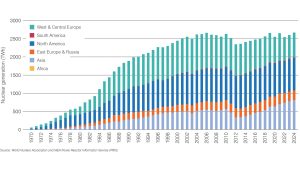The World Nuclear Association presents its latest performance report, provides insight into recent global trends, explores new countries participating in the nuclear energy industry, and explores advances towards carbon neutrality through the adoption of small modular reactors.
The World Nuclear Association (WNA) advocates nuclear power as an important factor in promoting the sustainable and responsible use of nuclear energy around the world, achieving global energy security and tackling climate change.
As part of this initiative, WNA will release its annual performance report, highlighting the current state of nuclear power generation and providing valuable insights and data on global trends and advancements in the nuclear industry. In anticipation of the 2025 performance report, the innovation platform has gotten to speak with WNA to understand the nuclear outlook this year and the challenges and opportunities ahead.
Can you provide an overview of the world’s nuclear power generation? What are the main statistics? Also, what does the performance report show about the nuclear construction situation around the world?
Nuclear reactors around the world generated 2667 TWH of electricity in 2024. This was the largest electricity produced in a year from nuclear energy, beating the previous best of 2660 TWH in 2006.
Nuclear reactors meet approximately 9% of the world’s electricity needs. This is down from the 16% share in the mid-1990s, despite an increase in nuclear power generation. A decline in share has occurred as global demand for electricity has increased much faster and is largely met by the addition of fossil fuels.
Seven reactors were completed in 2024 and connected to the grid for construction. Three of these were in China, while the other four were in the United Arab Emirates, France, India and the United States. There are currently 70 reactors under construction all over the world, and were built on nine reactors in 2024, six in China and one in Pakistan, Egypt and Russia.
Can you explain in detail the key trends and changes in the global nuclear market and landscape in 2025?
The global nuclear power growth seen in recent years is largely due to the rapid increase in nuclear power generation in Asia, with 56 of the 68 reactors launched over the past decade being built in the region. This appears to continue. Of the 70 nuclear reactors currently under construction, 59 are being built in Asian countries.
Most reactors under construction and planned are large-scale reactors, but soon you can see that SMR (small modular reactors) play a new role. The 125 Mwe Changjiang ACP100 is scheduled to begin in China next year, with construction of two 53 MWE RITM-200-year units coming soon in Russia. SMR construction is also expected to advance in countries such as Canada and the United States. These small reactors will expand the range of applications that allow nuclear technology to be applied, and in the long run, help reduce costs with factory-based module production and faster construction.
This report provides a national overview of nuclear capabilities. Which countries are showing significant advances or challenges in the nuclear energy sector?
China continues its nuclear program. It is the second largest country with nuclear reactors, surpassing France (58), and appears to overtake the United States, where more than 100 reactors are operating within the next decade.


It is also worth noting that the number of new countries have recently launched their first nuclear reactors (UAE and Belarus) or have the first nuclear reactors currently under construction (Bangladesh, Egypt, Turkey). The number of countries opting to use nuclear as part of their energy mix is growing as countries such as Kazakhstan, Poland and Uzbekistan are about to begin construction of their first reactors in the coming years.
What does the report reveal about global advances towards carbon neutrality? And what role does nuclear energy play in this transition? How is the nuclear energy industry positioned to contribute to climate targets for the coming years?
Global advances in carbon neutrality are happening too slowly. Even when the rapid growth of renewable energy is added to nuclear power, the global use of fossil fuels for electricity production continues to be driven by an overall increase in electricity demand. This increase in demand is expected to continue, according to the International Energy Agency. Electricity consumption is projected to more than double over the next 25 years due to increased demand from new sectors, including increased electricity usage in emerging economies and a significant increase in demand from AI and data centers.
The government recognizes the need for a rapid expansion of contributions from nuclear energy. In the 2023 COP28, a global stocktake document approved by all countries, nuclear was included as one of the mitigation technologies needed to reduce emissions. Additionally, 25 governments have signed a declaration in support of the goal of tripling global nuclear capabilities by 2050, and six more countries took part in the declaration in 2024 at Baku’s COP29.
That triple-fold goal is supported by pledges from more than 130 companies in the nuclear industry to work with the government and others to achieve that goal, and in 2024, 14 large energy users, including Amazon, Meta, Google and Dow, recognized the role of nuclear in tripling their nuclear goals, strengthening energy security, restoring and providing ongoing clean energy.
Does this report identify as having specific needs for innovation and investment advancement? How can we address these issues to increase the growth and sustainability of our industry?
From a technical standpoint, the nuclear possibility to decarbonise difficult sectors beyond electricity production and abolish them will require innovation to fully realize. Many of these potential applications involve the delivery of process heat at higher temperatures than those produced from traditional large water-cooled furnaces. Instead, gas, molten salts, or liquid metals are used as coolants, allowing process heat delivery up to 750°C, instead of the typical 300°C in a water cooling reactor. These alternative coolant technologies have already been demonstrated. What is needed is the continuous development and deployment of commercial reactors based on these technologies.
Financial innovation is also required for construction, especially in liberalized electricity markets. According to our Global Nuclear Supply Chain report, there is a huge potential market for new nuclear power, which requires a future investment of $1.8 trillion, as nearly 500 reactors are currently under construction, planned or proposed.
The finance department is tackling this issue. During the 2024 New York Climate Week, 14 financial organizations discussed how their sectors could support global goals to triple their nuclear capabilities.
Based on the findings of the 2025 report, what is the industry outlook for the 2026 World Nuclear Association? Do you expect it could have a major impact on nuclear development over the next few years?
In the short term, we should see global nuclear capabilities and total nuclear power generation continue to rise as nuclear reactors currently under construction are grid-connected for the next five to six years.
Although there may be closures of older plants, our analysis shows that for current reactor fleets, including reactors that have been operating for at least 50 years, age-related reactor performance has reduced, with older reactors achieving high capacity factors at least equal to newer reactors. In fact, we can see recently closed reactors reopening in the US.

In the long run, you may see two drivers that will encourage the pace of new nuclear builds. The first is the ongoing commitment to decarbonizing global power sources. But the second and perhaps more important drivers are increasing the demand for electricity. With this in mind, additional demands must be met with clean energy sources. To achieve these goals, you will need at least three times the nuclear capacity.
Read more
https://world-nuclue.org/our-association/publications/world-nuclue-performance-report/china-mainland-world-nucled-performance-report
2. https://netzeronuclue.org/news/major-global-companies-pledge-historiic-support-to-triple-nuclear-energy
This article will also be featured in the 23rd edition of Quarterly Publication.
Source link

